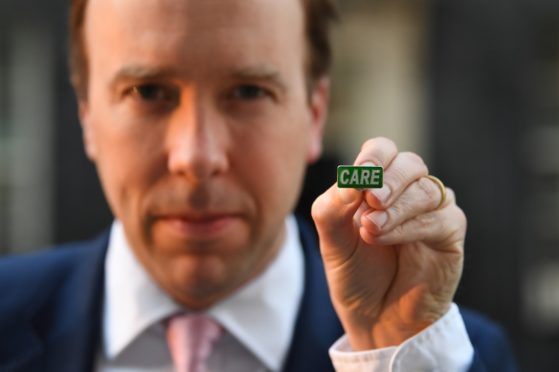
In response to increasing outrage at the plight of care workers, battling a virus that is cutting a swathe through our residential homes, the UK’s Health Secretary, Matt Hancock, rewarded them. With a badge.
A green enamel badge that says “CARE”. A “badge of honour” with its message writ large in capitals. A badge meant to give some parity with the NHS lapel pin that Hancock and others so prominently wear. A badge meant to symbolise the importance that these low-paid, undervalued and ill-equipped workers, should have for their delivery of vital care for our vulnerable citizens.
And a badge that was actually issued 12 months previously by the care home industry in response to the lopsided message Hancock himself sent out by only ever wearing his little NHS badge.
Care homes have become a focus point as reports of mass deaths have circulated. With one in four deaths so far linked to the coronavirus in Scotland involving residents, and 40% of the 1,000-plus care homes in Scotland reporting cases of infection, Scots have rightly been appalled.
And behind the daily tally of cold statistics lies the agony of grieving families unable to say a last goodbye and the toil of carers who balance the risk to their own lives simply by going to work.
At her daily briefing last week, Nicola Sturgeon was clearly moved by the unfolding tragedy. Who wouldn’t be? But at one point she said that “care homes can be more susceptible to infection outbreaks.” It stopped me in my tracks.
A care home should be no more susceptible to an infection outbreak than any other institutional setting. Indeed, given the experience every year of tackling the winter vomiting bug, it should arguably be even more ready. But then maybe this was an accident waiting to happen. The roots of this crisis predate this pandemic. Care homes have been left behind for decades. Under-resourced, their purpose not talked about, their privatisation an embarrassment, their staff undervalued, and their residents too often viewed as an inconvenience.
And as a result, the vital care these homes provide has been forgotten in the weekly celebration of the NHS. They have been at the back of the queue in the scramble for PPE, their beds have filled up as those in hospital have been emptied, they have not had access to routine testing and while vulnerable residents have been rushed into signing DNR forms, they have also been cut off from friends and family, their deaths not included in official statistics.
We were also given clear warning from European nations hit before us as horror stories emerged from care homes of mass deaths, abandoned bodies and fleeing staff in Italy, France and Spain.
This pandemic is brutal, but has shone a spotlight on a care system that has lived in the shadows of the NHS. The sector has suffered from an unnecessarily negative perception and at the heart of it all is a question of the bill, in pennies and pounds, we, as a society, are willing to pay.
This tragedy will hopefully see care for the elderly become as important as the NHS with the creation of a National Care Service that offers consistent and appropriate end-of-life living that isn’t just about waiting to die.

Enjoy the convenience of having The Sunday Post delivered as a digital ePaper straight to your smartphone, tablet or computer.
Subscribe for only £5.49 a month and enjoy all the benefits of the printed paper as a digital replica.
Subscribe